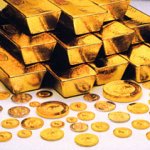We offer layaway, spread payments on the piece of your dreams. Ask us for details. Free insured shipping on all orders !!!

Antique jewelry glossary
Welcome to our extensive antique jewelry glossary with around 1,500 jewelry related entries.If you feel you are missing an explanation, feel free to let us know and we will add it.
A - B - C - D - E - F - G - H - I - J - K - L - M - N - O - P - Q - R - S - T - U - V - W - X - Y - Z all
Gold

A metallic element that is very heavy, the most malleable and ductile of all metals, and unalterable by heat, moisture, and most corrosive agents. Pure gold is too soft for most practicable uses, but as an alloy with silver, copper or other metals it serves ordinary purposes as jewelry or coins.
Gold is not susceptible to compression, so that when beaten it increases its surface area while losing thickness. It is basically yellow, but when alloyed it appears whitish, greenish, reddish or other hues. The proportion of gold in an alloy is expressed in fineness and carats. Gold has a high melting point (1063°C., 19450°F.). It is the most precious metal used as a medium of monetary exchange but platinum is more valuable as a metal. Gold is used in gilding.
Earliest gold objects were made of sheets of gold decorated in relief by being punched and hammered (see embossing; repouseé) or by stamping, or in the case of objects in the round by the lost wax (cire perdue) process or being beaten into two hemispherical moulds and then soldered together. It was also used decoratively as strips, rods, and wire.
From: An Illustrated Dictionary of Jewelry, autor: Harold Newman, publishers: Thames and Hudson









